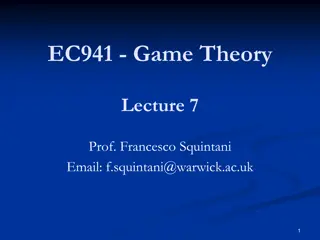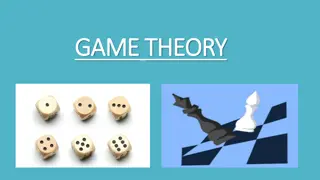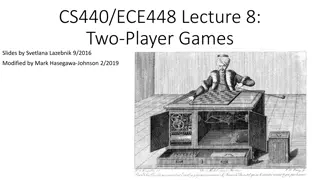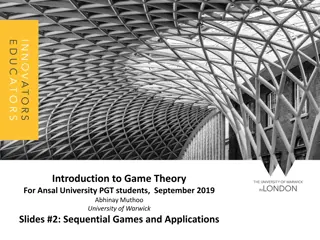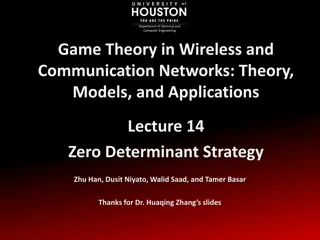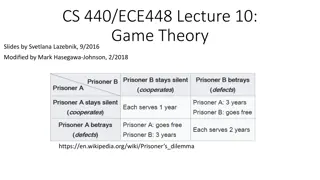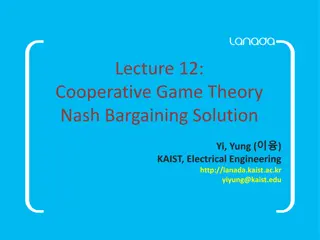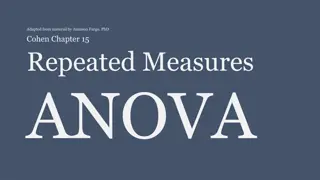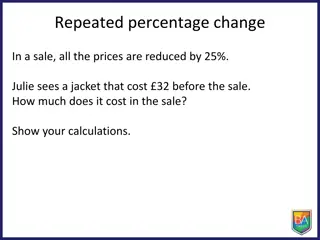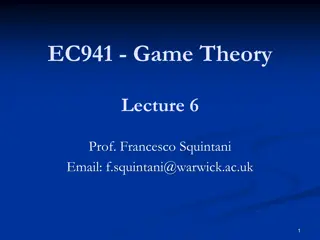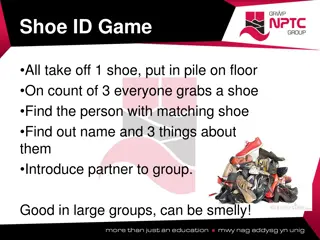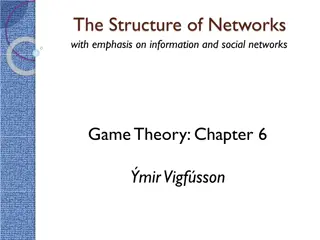Game Theory with Engineering Applications: Repeated Games
Delve into the intricacies of repeated games in game theory, including finitely and infinitely repeated games with and without perfect monitoring, trigger strategies, and folk theorems. Explore the concept of subgame perfect equilibrium (SPE) in finitely repeated games through examples like the Prisoners Dilemma, and understand the unique properties of SPE in such games. Unpack the dynamics of infinitely repeated games and the role of trigger strategies in maintaining equilibrium. Dive into the insights provided by backward induction and the importance of strategic decision-making in repeated game scenarios.
Download Presentation

Please find below an Image/Link to download the presentation.
The content on the website is provided AS IS for your information and personal use only. It may not be sold, licensed, or shared on other websites without obtaining consent from the author. Download presentation by click this link. If you encounter any issues during the download, it is possible that the publisher has removed the file from their server.
E N D
Presentation Transcript
ECE700.07: Game Theory with Engineering Applications Lecture 6: Repeated Games Seyed Majid Zahedi
Outline Finitely and infinitely repeated games w/ and w/o perfect monitoring Trigger strategies Folk theorems Readings: MAS Sec. 6.1, GT Sec. 5.1 and 5.5
Finitely Repeated Games (with Perfect Monitoring) In repeated games, stage game ? is played by same agents for R rounds Agents discount utilities by discount factor 0 ? 1 Game is denoted by ??? At each round, outcomes of all past rounds are observed by all agents Agents overall utility is sum of discounted utilities at each round Given sequence of utilities ?? 1, ,?? ? In general, strategies at each round could depend on history of
Example: Finitely-Repeated Prisoners Dilemma Suppose that Prisoners Dilemma is played in R (< ) rounds Prisoner 2 Stay Silent Confess Prisoner 1 Stay Silent (-1, -1) (-3, 0) Confess (0, -3) (-2, -2) What is SPE of this game? We can use backward induction Starting from last round, (C, C) is dominant strategy Regardless of history, (C, C) is dominant strategy at each round There exists unique SPE which is (C, C) at each round
SPE in Finitely Repeated Games [Theorem] If stage game ? has unique pure strategy equilibrium ? , then ??? has unique SPE in which ??= ? for all ? = 1, ,?, regardless of history [Proof] By backward induction, at round ?, we have ??= ? Given this, then we have ?? 1= ? , and continuing inductively, ??= ? for all ? = 1, ,?, regardless of history
Infinitely Repeated Games Infinitely repeated play of ? with discount factor ? is denoted by ? ? Agents utility is average of discounted utilities at each round For ? < 1, given sequence of utilities ?? 1, ,?? For ? = 1, given sequence of utilities ?? 1, ,??
Trigger Strategies (TS) Agents get punished if they deviate from agreed profile In non-forgiving TS (or grim TS), punishment continues forever Here, ? is agreed profile, and ?? agent ? Single deviation by ? trigers agent ? to switch to ?? ?is punishment strategy of ? for ?, forever
Trigger Strategies in Repeated Prisoners Dilemma Prisoner 2 Suppose both agents use following trigger strategy Play S unless someone has ever played C in past Play C forever if someone has played C in past Under what conditions is this SPE? We use one-stage deviation principle Step 1: (S is best response to S) Utility from S: 1 ? 1 + ? + ?2+ = 1 ? / 1 ? = 1 Utility from C: 1 ? 0 + 2? + 2?2+ = 2? 1 ? / 1 ? = 2? S is better than C if ? 1/2 Step 2: (C is best response to C) Other agents will always play C, thus C is best response Stay Silent Confess Prisoner 1 Stay Silent (-1, -1) (-3, 0) Confess (0, -3) (-2, -2)
Remarks Cooperation is equilibrium, but so are many other strategy profiles If ? is NE of ?, then each agent plays ?? Future play of other agents is independent of how each agent plays Optimal play is to maximize current utility, i.e., play static best response Sets of equilibria for finite and infinite horizon versions can be different Multiplicity of equilibria in repeated prisoner s dilemma only occurs at ? = For any finite ? (thus for ? ), repeated prisoners dilemma has unique SPE is SPE of ???
TS in Finitely Repeated Games If ? has multiple equilibria, then ??(?) does not have unique SPE Consider following example Agent 2 x y z Agent 1 x (3, 3) (0, 4) (-2, 0) y (4, 0) (1, 1) (-2, 0) z (0, -2) (0, -2) (-1, -1) Stage game has two pure NE: (y, y) and (z, z) Socially optimal outcome, (x, x), is not equilibrium In twice repeated play, we can support (x, x) in first round
TS in Finitely Repeated Games (cont.) TS strategy Play x in first round Play y in second round if opponent played x; otherwise, play z We can use one-shot deviation principle For simplicity, suppose ? = 1 Playing x first and y next leads to utility of 4 Playing y first triggers opponent to play z next, which leads to utility 3 Deviation is not profitable!
Repetition Can Lead to Bad Outcomes Consider this game Agent 2 x y z Agent 1 x (2, 2) (2, 1) (0, 0) y (1, 2) (1, 1) (-1, 0) z (0, 0) (0, -1) (-1, -1) Strategy x strictly dominates y and z for both agents Unique Nash equilibrium of stage game is (x, x) If ? 1/2, this game has SPE in which (y, y) is played in every round It is supported by slightly more complicated strategy than grim trigger I. Play y in every round unless someone deviates, then go to II II. Play z. If no one deviates go to I. If someone deviates stay in II
Feasible and Individually Rational Utilities ? = Convex hull of ? Utility in repeated game is just a weighted average of utilities in stage game Note that ? ? there exists ? such that ? ? = ? Recall minmax value of agent ? there exists ? ? such that ? s = ? Also recall minmax strategy against ? Utility vector ? is strictly individually rational if ??> ??, ?
Example What is minimax value of agent 1? Agent 2 L R Agent 1 U (-2, 2) (1, -2) Let ? denote probability that agent 2 chooses L M (1, -2) (-2, 2) D (0, 1) (0, 1) What is minimax value of agent 2? Let ? and ? denote probabilities that agent 1 chooses U and M, respectively
Minmax Utility Lower Bounds [Theorem] If ? is NE of ?, then ??? ?? If ? is NE of ? ? , then ??? ?? [Proof] Agent ? can always guarantee herself ??in stage game and also in each round of repeated game, meaning that she can always achieve at least this utility against even most adversarial opponents
Nash Folk Theorem [Nash Folk Theorem] If ? is feasible and strictly individually rational, then there exists ? < 1, such that for all ? > ?, ? ? has NE with utilities ? [Proof] Suppose for simplicity that there exists pure strategy profile ? such that ??? = ??(otherwise, proof is more involved) Consider following grim trigger strategy for agent ? Play ??as long as no one deviates If some agent ? deviates, then play ?? If ? plays ?, her utility is ?? ?thereafter
Proof of Nash Folk Theorem We can use one-shot deviation principle Suppose ? deviates from ? in round ? Define ??= max ?? We have ????,? ? Following ? will be optimal if This means, ? is NE of ? ? if
Problems with Nash Folk Theorem Any utility can be achieved when agents are patient enough NE involves non-forgiving TS which may be costly for punishers NE may include non-credible threats NE may not be subgame perfect Example: Unique NE in this game is (D, L) Minmax values are given by ?1= 0 and ?2= 1 Minmax strategy against agent 1 requires agent 2 to play R R is strictly dominated by L for agent 2 Agent 2 L R Agent 1 U (6, 6) (0, -100) D (7, 1) (0, -100)
Subgame Perfect Folk Theorem [Theorem] Let ? be NE of stage game ? with utilities ? For any feasible utility ? with ??> ?? ? > ?, ? ? has SPE with utilities ? [Proof] Simply construct non-forgiving TS with punishment by static NE Punishments are therefore subgame perfect For ? sufficiently close to 1, it is better for each agent ? to obtain ??rather than deviate and get ?? This shows that any utility higher than NE utilities can be sustained as SPE , ? , there exists ? < 1 such that for all forever thereafter
Repeated Games with Imperfect Monitoring At each round, all agents observe some public outcome, which is correlated with stage game actions Let ? ? denote publicly observed outcome Each strategy profile ? induces probability distribution over ? Let ? ?,? denote probability distribution of ? under action profile ? Public information at round ? is r= ?1, ,?r 1 Strategy of agent ? is sequence of maps ?? ?: ? ??
Repeated Games with Imperfect Monitoring (cont.) Each agent s utility depends only on her own action and public outcome Dependence on actions of others is through their effect on distribution of ? Agent ? s realized utility at round ? is Given strategy profile ??, agent ? s expected utility is Agent ? s average discounted utility for sequence {??} is
Example: Cournot Competition with Noisy Demand [Green and Porter, Noncooperative Collusion under Imperfect Price Information, 1984] Firms set production levels ?1 Firms do not observe each other s output levels Market demand is stochastic Market price depends on total production and market demand Low price could be due to high production or low demand Firms utility depends on their own production and market price rprivately at round ? r, ,??
Simpler Example: Noisy Prisoners Dilemma Prisoners don t observe each others actions, they only observe signal ? ?1?,? = 1 + ? ?1?,? = 4 + ? ?2?,? = 1 + ? ?2?,? = 4 + ? Signal ? is defined by continuous random variable ? with ? ? = 0 If ? = ?,? , then ? = ? If ? = ?,? or ?,? , then ? = ? 2 If ? = ?,? , then ? = ? 4 Normal form stage game is Prisoner 2 Stay Silent Confess Prisoner 1 Stay Silent (1+X, 1+X) (-1+X, 2+X) Confess (2+X, -1+X) (X, X)
Trigger-Price Strategy Consider following trigger strategy for noisy Prisoner s Dilemma (I) - Play (S, S) until ? ? , then go to (II) (II) - Play (C, C) for ? rounds, then go back to (I) Note that punishment uses NE of stage game We can choose ? and ? such that this strategy profile is SPE We use one-shot deviation principle Deviation in (II) is obviously not beneficial In (I), if agents do not deviate, their expected utility is
Trigger-Price Strategy (cont.) If some agent deviates in (1), then her expected utility is Deviation provides immediate utility, but increases probability of entering (II) To have SPE, we mush have ? ??which means Any ? and ? that satisfy this constraint construct SPE Best trigger-price strategy could be found if we maximize ? subject to this constraint
Acknowledgement This lecture is a slightly modified version of one prepared by Asu Ozdaglar [MIT 6.254]



